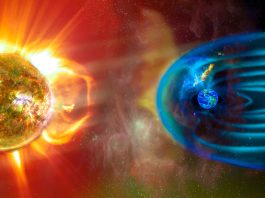Astronomers have peered through an exoplanet atmosphere beyond the Solar System, mapping its 3D structure for the first time.
By combining all four telescope units of the European Southern Observatory’s Very Large Telescope (ESO’s VLT), they found powerful winds carrying chemical elements like iron and titanium, creating intricate weather patterns across the exoplanet atmosphere.
The discovery opens the door for detailed studies of the chemical makeup and weather of other alien worlds.
“This exoplanet’s atmosphere behaves in ways that challenge our understanding of how weather works — not just on Earth, but on all planets. It feels like something out of science fiction,” commented Julia Victoria Seidel, a researcher at the European Southern Observatory (ESO) in Chile and lead author of the study.
Exoplanet’s atmosphere reveals distinct winds
The exoplanet, WASP-121b (also known as Tylos), is some 900 light-years away in the constellation Puppis. It’s an ultra-hot Jupiter, a gas giant orbiting its host star so closely that a year there lasts only about 30 Earth hours.
Moreover, one side of the planet is scorching, as it is always facing the star, while the other side is much cooler.
The team has now probed deep inside the Tylos’s atmosphere and revealed distinct winds in separate layers, forming a map of the atmosphere’s 3D structure. It’s the first time astronomers have been able to study an exoplanet atmosphere in such depth and detail.
Seidel explained: “We were surprised to find that a jet stream rotates material around the planet’s equator, while a separate flow at lower levels of the atmosphere moves gas from the hot side to the cooler side.
“This kind of climate has never been seen before on any planet.”
The observed jet stream spans half of the planet, gaining speed and violently churning the atmosphere high up in the sky as it crosses the hot side of Tylos.
3D materials allow for deep weather observations
To uncover the 3D structure of the exoplanet’s atmosphere, the team used the ESPRESSO instrument on ESO’s VLT to combine the light of its four large telescope units into a single signal.
This combined mode of the VLT collects four times as much light as an individual telescope unit, revealing fainter details. By observing the planet for one full transit in front of its host star, ESPRESSO was able to detect signatures of multiple chemical elements, probing different layers of the atmosphere as a result.
Leonardo dos Santos, an assistant astronomer at the Space Telescope Science Institute in Baltimore, United States, said: “The VLT enabled us to probe three different layers of the exoplanet’s atmosphere in one fell swoop.
“It’s the kind of observation that is very challenging to do with space telescopes, highlighting the importance of ground-based observations of exoplanets.”
Some surprising discoveries
The team tracked the movements of iron, sodium and hydrogen, which allowed them to trace winds in the deep, mid and shallow layers of the exoplanet atmosphere, respectively.
Interestingly, the observations also revealed the presence of titanium just below the jet stream, as highlighted in a companion study published in Astronomy and Astrophysics.
This was another surprise since previous observations of the planet had shown this element to be absent, possibly because it’s hidden deep in the atmosphere.
“It’s truly mind-blowing that we’re able to study details like the chemical makeup and weather patterns of a planet at such a vast distance,” said Bibiana Prinoth, a PhD student at Lund University, Sweden, and ESO, who led the companion study.
In the future, larger telescopes will be needed to uncover the atmospheres of Earth-like planets. They will include ESO’s Extremely Large Telescope (ELT), which is currently under construction in Chile’s Atacama Desert, and its ANDES instrument.









